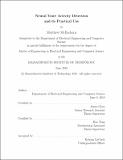Neural Voice Activity Detection and its practical use
Author(s)
McEachern, Matthew
DownloadFull printable version (4.477Mb)
Alternative title
Neural VAD and its practical use
Other Contributors
Massachusetts Institute of Technology. Department of Electrical Engineering and Computer Science.
Advisor
James Glass and Hao Tang.
Terms of use
Metadata
Show full item recordAbstract
The task of producing a Voice Activity Detector (VAD) that is robust in the presence of non-stationary background noise has been an active area of research for several decades. Historically, many of the proposed VAD models have been highly heuristic in nature. More recently, however, statistical models, including Deep Neural Networks (DNNs) have been explored. In this thesis, I explore the use of a lightweight, deep, recurrent neural architecture for VAD. I also explore a variant that is fully end-to-end, learning features directly from raw waveform data. In obtaining data for these models, I introduce a data augmentation methodology that allows for the artificial generation of large amounts of noisy speech data from a clean speech source. I describe how these neural models, once trained, can be deployed in a live environment with a real-time audio stream. I find that while these models perform well in their closed-domain testing environment, the live deployment scenario presents challenges related to generalizability.
Description
Thesis: M. Eng., Massachusetts Institute of Technology, Department of Electrical Engineering and Computer Science, 2018. This electronic version was submitted by the student author. The certified thesis is available in the Institute Archives and Special Collections. Cataloged from student-submitted PDF version of thesis. Includes bibliographical references (pages 87-90).
Date issued
2018Department
Massachusetts Institute of Technology. Department of Electrical Engineering and Computer SciencePublisher
Massachusetts Institute of Technology
Keywords
Electrical Engineering and Computer Science.